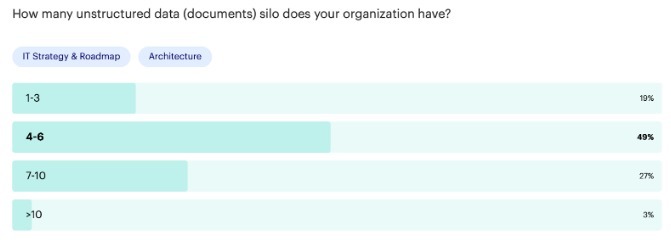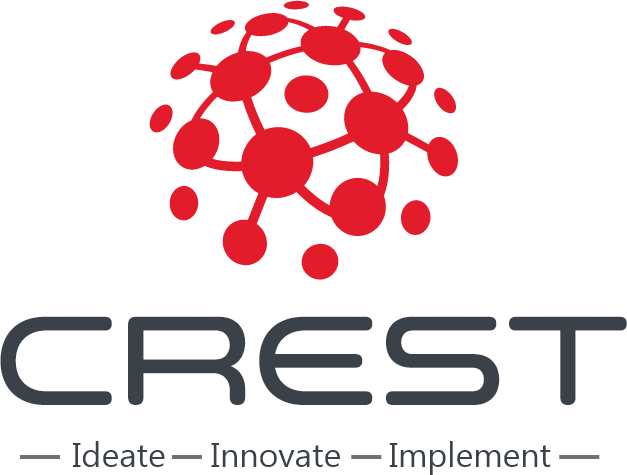In the age of AI, hybrid work, and relentless digital acceleration, unstructured data is growing at an unprecedented rate—and most of it lives in the documents. But when those documents are scattered across disconnected platforms, departments, and legacy repositories, organizations face a hidden but critical problem: document silos.
According to recent industry data:
49% of organizations have between 4–6 unstructured document silos, 27% have 7-10 repositories and 03% operate with more than 10.
That means over 8 in 10 enterprises are struggling to manage fragmented, siloed content ecosystems.
For CIOs, CXOs, and enterprise data architects, this isn’t just a content management issue—it’s a strategic threat. Silos cost money, time, and control. They hamper compliance, slow decision-making, and make your organization less agile in responding to market shifts.
The Real Cost of Document Silos
Document silos occur when business content is stored in isolated systems—file shares, email inboxes, SharePoint sites, cloud drives, or legacy ECMs. Often, each department has its own preferred tool or platform to store documents.
The Consequences:
- Productivity suffers: Employees waste time locating files in multiple repositories, chasing versions, working with outdated information or often duplicating information by generating it again or asking customers or suppliers to resubmit the documents.
- Costs escalate: Redundant storage, duplicated efforts, and integration overhead drive up operational expenses and consumes IT budget.
- Compliance risk rises: Siloed systems lack consistent governance, increasing exposure to data loss, audit failure, or regulatory fines.
In regulated industries such as banking, finance, insurance, healthcare, or public sector, these risks can be existential. Disparate document stores make it difficult to apply consistent retention, access, and classification policies—undermining knowledge management, records management strategies and digital transformation roadmaps.
Strategic Imperatives for CIOs and Technology Leaders
To address the document silo challenge, CIOs must move beyond temporary workarounds and adopt a strategic, enterprise-wide approach to content unification.
Here’s how:
- Identify the source of documents
Begin by identifying the origin of documents, both internally and from external sources, by department and business units and catalogue them by document classification and formats.
- Audit and Classify Content Sources
Identify all existing repositories of unstructured data—including cloud, on-prem, legacy, shadow IT, and personal drives and the ownership of systems and data. Use metadata analysis and AI tools to classify documents by business function, sensitivity, and usage.
- Reduce Redundancy and Streamline Access
Remove obsolete repositories and rationalize where content is stored. For active collaboration, reduce sprawl by integrating and federating access to key systems rather than duplicating content.
- Standardize Metadata and Retention Policies
Define global standards for document metadata, access rights, and lifecycle management. Apply these consistently across systems via automated policies.
- Embed Governance and Compliance by Design
Use role-based access control (RBAC), versioning, audit trails, and automated retention enforcement to maintain compliance without operational friction.
Best Practice: Deploy a Unified, Scalable, and Secure Document Management Platform
The most effective way to dismantle document silos is to deploy a modern content services platform that’s scalable, secure, and extensible—capable of managing documents, records, rich media, and more in a unified architecture.
Expert help is recommended to choose the right fit technology platform for your business, from the available options from various technology vendors. An ECM / DMS consulting expert, having diverse platform experience will be good choice, instead of single technology stack background.
Key Capabilities to Look For:
A. Connector Ecosystem
Choose a platform with native connectors to the tools your business already uses:
- Collaboration platforms: Google Drive, Microsoft 365, OneDrive, SharePoint, Teams, Box, Dropbox etc.
- Business apps: SAP, Salesforce, Workday, ServiceNow or similar apps used in your business environment.
- Legacy file shares or ECMs for phased migration or hybrid operation.
This ensures users can access and manage content in their native workflows while applying consistent governance in the background.
B. Support for Diverse Content Types
Look for systems that can manage:
- Microsoft Office and OpenOffice document formats (Word, Excel, PowerPoint).
- PDFs and scanned images, including TIFF, JPEG, PNG formats.
- Emails in msg and eml formats.
- HTML, Audio, video, CAD, and GIS files (if belong to engineering domain).
C. Enterprise-Grade Security and Compliance
Ensure the platform supports:
- End-to-end encryption (AES-256, TLS 1.2+).
- Retention and legal hold.
- Data residency and sovereignty controls.
- Compliance frameworks like ISO 27001, GDPR, HIPAA etc.
D. Scalability and Cloud Readiness
Prefer a cloud-native solution, than a cloud-only solution with support for multi-cloud, hybrid deployments, and elastic scaling is critical for future-proofing your investment.
A cloud-only solution, tied to the proprietary services of a specific cloud or infrastructure platform can be hindrance to the organizational agility and ability to move to a different infrastructure platform in future with ever-changing technology landscape.
Open APIs for integration and to move the data in and out of platform without vendor dependence is essential to meet the business continuity requirements.
E. Built-In AI and Automation
Choose platforms with AI services such as:
- Document categorization and security classification.
- OCR and Metadata extraction.
- Document summarization, transcription can be a plus.
- Automatic language translation.
- Sensitive information like PII redaction based on configurable rules.
- Natural language search.
F. User Experience Matters
User adoption is the key to project success. A high degree of project failures happen due to rejection to users, and underlying factors are mostly the cumbersome user interface, making it difficult for users to locate the desired functionality or information.
Traditionally ECM and DMS systems didn’t offer great user experience and robust Mobile Apps, but that’s changing fast.
Lean and modern UI/UX with guided navigation, with preferably an extensible mobile app can address this challenge and improve project success rate.
Data in Focus: The Silo Problem Is Widespread
A recent survey on the Gartner Peer Community portal highlights the scale of the problem:

Figure 1: Gartner Peer Community Poll Results
View the latest statistics at the Link on Gartner Peer Community portal.
Over 79% of organizations operate with four or more document silos—clearly showing this is not an isolated issue, but an enterprise epidemic is this going to get worse?
What’s at Stake? Unlocking Business Value
Once silos are removed and unified content governance is in place, CIOs can drive measurable impact:
30–50% reduction in time spent searching for documents.
- Stronger security and audit readiness.
- Better integration across business functions and workflows.
- Increased adoption of GenAI tools for insight extraction.
- Lower TCO from reduced duplication, storage, and license waste.
More importantly, organizations become agile, resilient, and innovation-ready.
Final Thoughts: Seize the Opportunity
Document silos are not just a technical problem—they’re a leadership opportunity. CIOs and data architects must act now to unify their content landscape and lay the foundation for AI-driven business transformation.
The most strategic move?
Invest in a content services platform that bridges the gap between collaboration and compliance, between user freedom and IT control.
Because in the digital era, control over your documents is control over your future.






